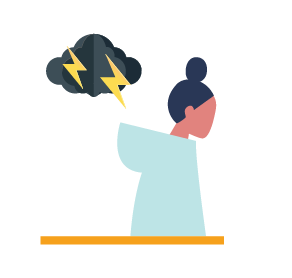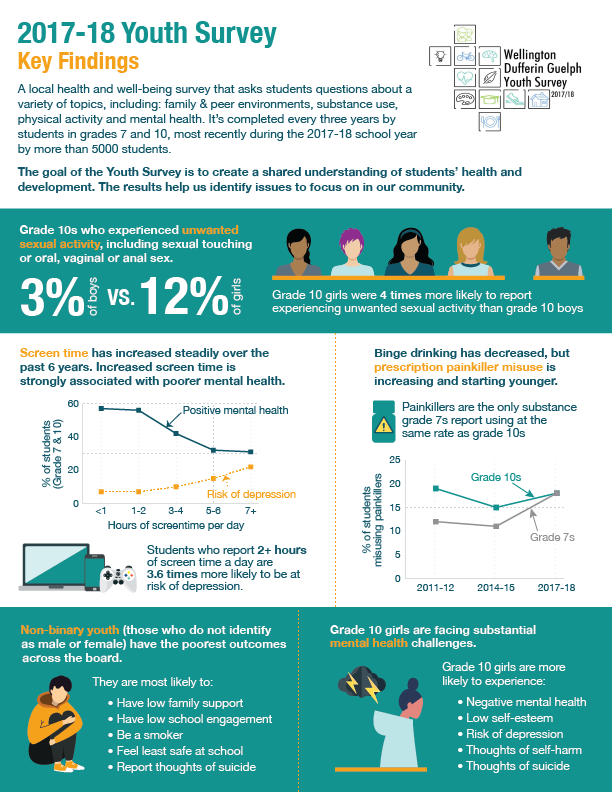Every three years since the 2011-12 school year we’ve asked students in grades 7 and 10 to tell us about their health and well-being. And they’ve answered! Their responses to questions about physical activity, screen time, bullying, substance use and mental health might surprise you.
Whether you work with teens or have one at home, we hope you’ll be able to use these key findings from the 2017-18 Youth Survey to start a conversation.
Youth survey tracks students’ health and development
To stay current, the most recent version of the Survey included new questions to address e-cigarettes, cannabis, the use of cough or cold medicine to get high, sending sexual photos or messages (“sexting”) and experiences of unwanted sexual activity.
The 2017-18 Survey was completed by more students than ever before. More than 5,300 students in Wellington, Dufferin and Guelph took the survey. That is about 90 percent of all students enrolled in grades 7 and 10.
What did they tell us?

The 2017-18 WDG Youth Survey results provide a detailed snapshot of what youth in our community are experiencing. By comparing the 2017-18 results to earlier surveys, we are able to understand emerging trends among youth.
Positive changes since the 2011-12 survey include:
- More students report positive family life.
- Fewer students report being bullied at school.
- Past-year binge drinking has decreased among grade 7’s and 10’s.
However, there are some pressing needs among youth as well.
Prescription painkiller misuse increased and is starting younger.

Nearly one in five grade 7 and 10 students report using a pain pill (such as Percocet, Tylenol #3 or codeine) without a prescription in the past year.
Prescription painkillers are the only substance that grade 7 students report consuming at the same rate as grade 10 students. They are also the most common substance used among grade 7’s; far more prevalent than binge drinking, smoking and cannabis use combined.
One in eight grade 10 girls reported experiencing unwanted sexual activity.

All grade 10 students who completed the 2017-18 WDG Youth Survey were asked if they had ever experienced sexual activity when they did not want to or did not give their consent. Girls and non-binary students (non-binary students do not identify as male or female) were much more likely to report experiencing unwanted sexual activity than boys.
Screen time has increased steadily over the past 6 years.

The Canadian 24-hour Movement Guidelines for Children and Youth recommend no more than two hours of recreational screen time a day. In 2017-18, 64 percent of youth who completed the WDG Youth Survey reported exceeding these guidelines.
In fact, 28 percent of youth reported engaging in five or more hours of screen time a day. This is particularly concerning, as increased screen time was linked to poorer mental health. Students who reported more than two hours of screen time a day were 3.6 times more likely to be at risk for depression.
Grade 10 girls are facing substantial mental health challenges.

Adolescence can be a challenging time for mental health. Across all three WDG Youth Surveys, grade 10 students have reported more mental health challenges than grade 7 students. The difference between grade 7 and 10 students is particularly noticeable among girls. Grade 10 girls are less likely to report positive mental health and high self-esteem. They are also more likely to be at risk for depression and report thoughts of self-harm and suicide. This pattern can also be seen in other data sources, such as hospitalization rates for mental and behavioral disorders.
Non-binary youth (those who do not identify as male or female) have the poorest outcomes across the board.

All students who complete the WDG Youth Survey are asked about their gender identity. “Non-binary” refers to students who selected a gender identity other than male or female. In 2017-18, approximately 100 non-binary students completed the Survey. Students who identified as non-binary consistently reported poorer outcomes than male and female students. Non-binary youth were:
- 2.3 times more likely to experience low family support
- 3.4 times more likely to feel unsafe in school
- 4.4 times more likely to report thoughts of suicide
More findings
You can see more data from the 2017-18 Youth Survey, as well as comparisons to previous years, on the Report Card Coalition’s Data Portal at WDGReportCard.com.
How is this information being used?
The 2017-18 WDG Youth Survey results have been shared widely in Wellington, Dufferin and Guelph to help inform change and address these pressing needs. Each school that participated in the Survey received a report with their school-level results. These results are used to inform school initiatives, such as Healthy Schools plans. Survey results have also been shared with community planning tables and will be used to inform service planning for children and youth.

Text Summary of Graphic
2017-18 Youth Survey: Key Findings
A local health and well-being survey that asks students questions about a variety of topics including: (i) family & peer environments; (ii) substance use; (iii) physical activity; and (iv) mental health. It’s completed every three (3) years by students in grades 7 and 10, and, most recently during the 2017-18 school year by more than 5000 students.
The goal of the Youth Survey is to create a shared understanding of students’ health and development. The results help us identify issues to focus on in our community.
- Among grade 10 students, 3% of boys and 12% of girls experienced unwanted sexual activity including: (i) sexual touching; or (ii) oral, vaginal or anal sex.
- Grade 10 girls were 4 times more likely to report experiencing unwanted sexual activity than grade 10 boys.
- Screen time has increased steadily over the past 6 years.
- Increased screen time is strongly associated with poorer mental health.
- Students who report 2+ hours of screen time a day are 3.6 times more likely to be at risk of depression.
|
HOURS OF SCREEN TIME PER DAY |
PERCENT OF STUDENTS WITH POSITIVE MENTAL HEALTH |
PERCENT OF STUDENTS AT RISK OF DEPRESSION |
|---|---|---|
|
Less than 1 hour a day |
57% |
7% |
|
1 or 2 hours a day |
56% |
7% |
|
3 or 4 hours a day |
42% |
10% |
|
5 or 6 hours a day |
32% |
15% |
|
7 or more hours a day |
31% |
22% |
- Binge drinking has decreased but prescription painkiller misuse is increasing and starting younger.
- Painkillers are the only substance grade 7 students report using at the same rate as grade 10 students.
|
PERCENT OF STUDENTS MISUSING PAINKILLERS |
|||
|---|---|---|---|
|
|
2011-12 |
2014-15 |
2017-18 |
|
Grade 7s |
12% |
11% |
18% |
|
Grade 10s |
19% |
15% |
18% |
- Non-binary youth (those who do not identify as male or female) have the poorest outcomes.
- They are most likely to:
- Have low family support;
- Have low school engagement;
- Be a smoker;
- Feel least safe at school; and
- Report thoughts of suicide.
- They are most likely to:
- Grade 10 girls are facing substantial mental health challenges.
- Grade 10 girls are more likely to experience:
- Negative mental health;
- Low self-esteem;
- Risk of depression;
- Thoughts of self-harm; and
- Thoughts of suicide.
- Grade 10 girls are more likely to experience:
